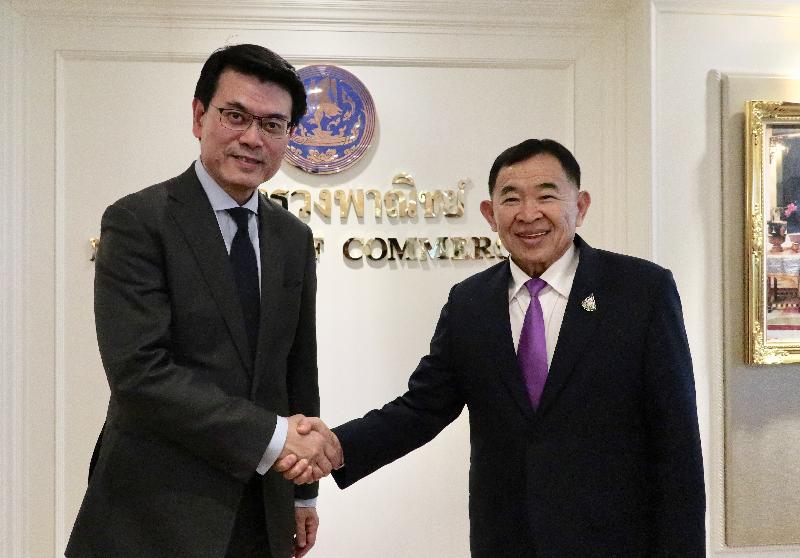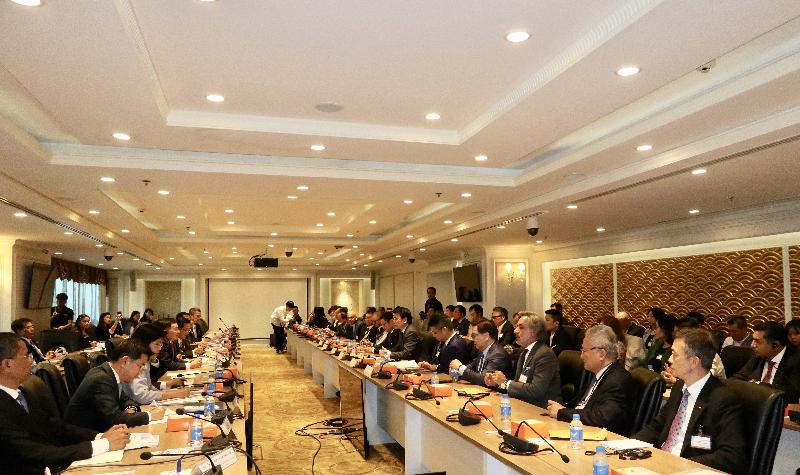LCQ15: Police use tear gas to curb acts of violence and illegal acts
Following is a question by the Professor Hon Joseph Lee and a written reply by the Secretary for Security, Mr John Lee, in the Legislative Council today (November 27):
Question:
Since the eruption of the "anti-extradition to China" movement in June this year, the Police have fired thousands of tear gas rounds to disperse demonstrators. It has been reported that on the 2nd of this month, a volunteer first-aider was allegedly shot by a tear gas round made in China which resulted in serious burns on his back. Besides, as measured by some reporters at the scenes of conflicts, the temperature of the sparks discharged during combustion of tear gas rounds was as high as 252 degrees Celsius, which can set alight miscellaneous objects and cause second degree burns in human bodies. In this connection, will the Government inform this Council:
(1) of the total number of tear gas rounds fired by the Police since June this year, and in respect of the 10 days on which the largest quantities of tear gas rounds were fired, the (i) relevant dates, (ii) quantities of tear gas rounds fired and (iii) locations where they were fired;
(2) whether, at present, the Police have procured tear gas rounds which are not made in China; if so, (a) of the places of origin of such tear gas rounds, and (b) how such tear gas rounds compare with those which are made in China in the following aspects: (i) composition, (ii) velocity of explosion, (iii) power (including the functions, effects and the highest temperature during combustion), and (iv) possible impacts on human health (set out in a table); if not, the reasons for that;
(3) whether the Police have, before procurement, conducted tests for the tear gas rounds made in China on the various aspects mentioned in (2); if so, of the details of the test results; and
(4) whether the Police have issued guidelines to police officers, relevant government departments, public organisations and members of the public in respect of how to clean up tear gas residue at the scenes where tear gas rounds have been fired and how to deal with the aftermath; if so, of the details; if not, the reasons for that?
Reply:
President,
The Police have a statutory duty to maintain public safety and public order. When public order and public safety are severely threatened by situations such as illegal blockage of roads, paralysed traffic, unlawful assemblies and violent charging of police cordon lines, the Police must take appropriate actions to maintain law and order and safeguard public peace. If the public express their views in a peaceful and lawful manner, there would be no need for the Police to use any force.
Since early June 2019 up till now, more than 900 protests, processions and public assemblies have been staged in Hong Kong, and many of them ended up as violent illegal activities. In the past five months or so, rioters repeatedly committed serious unlawful acts including wantonly blocking roads, paralysing the traffic, hurling petrol bombs and bricks and setting fire at different locations, vandalising and burning shops and MTR and Light Rail facilities with intent, and violently assaulting people holding different opinions. These acts have seriously threatened personal safety, as well as public order and public safety. To curb violent illegal acts, the Police had to take actions to bring rioters to justice or disperse the crowds and control the situations so as to restore public safety and public order.
My reply to Professor Hon Joseph Lee’s question is as follows:
(1) Tear gas is a crowd dispersal equipment, the purpose of which is to stop people from gathering or conducting illegal acts. Since June up till now, the Police have used around 10 000 rounds of tear gas. The use of tear gas by the Police is in response to the prevailing situation, the location and extent of using it depend on rioters’ violent acts and circumstances at the scene. Details on the 10 days with the highest number of tear gas being used are at Annex. According to police records, rioters committed acts of vandalism and violence in various parts of Hong Kong during the listed days. As a result, the Police need to take appropriate action, including the use of tear gas for dispersal, in order to curb acts of violence and illegal acts.
(2) and (3) On the procurement of equipment and ammunitions, the Police have been sourcing globally for safe and suitable equipment and ammunitions in accordance with the established procedures to meet their operational needs. The tear gas procured by the Police has passed safety tests for ensuring that the stability and safety of such ammunitions comply with relevant specifications.
As the procurement details of the equipment used by the Police involve operational deployment, it would be inappropriate to disclose such details as it would affect the Police’s operational capability. The Police will continue the safe use of tear gas in accordance with the manufacturer’s guidelines and internal ones.
(4) In general, post-exposure symptoms to tear gas may include burning sensation to the skin and eyes, coughing, sneezing and temporary breathing difficulty resulted from irritation to the nose and throat. These symptoms will usually subside after a short period of time.
I must reiterate that it is not for the Police to choose the location to use tear gas against violence or illegal acts, but depends on the rioters who committed violence or illegal acts and where they choose to commit such acts.
The Police understand the community's concerns about the use of tear gas near residential area, and will take into account the safety and interests of the affected people as far as possible when using the tear gas. Before the operation, the Police will, as far as possible, maintain close contact with the nearby building management offices, commercial tenants and elderly homes through various channels to remind them of the Police's possible actions in relation to the demonstrations so that they can make arrangements accordingly. During the operation, the Police will also appeal to residents in the vicinity to pay attention to the situation through social media and press releases, and to close the windows and stay in a safe place indoors if necessary.
The Government fully understands the community’s concern about the impacts of tear gas on the environment and physical health. The Department of Health has uploaded health information on tear gas to the Centre for Health Protection webpage for public reference. In general, health effects of tear gas depend on a number of factors such as specific chemical composition of the tear gas, duration and dose of exposure to tear gas, exposure route, health conditions of the individuals and the physical environment during exposure. Individuals with persistent post-exposure symptoms to tear gas should promptly consult healthcare professionals. The Food and Environmental Hygiene Department has also issued guidelines to its staff and cleansing contractors, which include matters for attention and personal protective gear in respect of removal of chemical residues.


